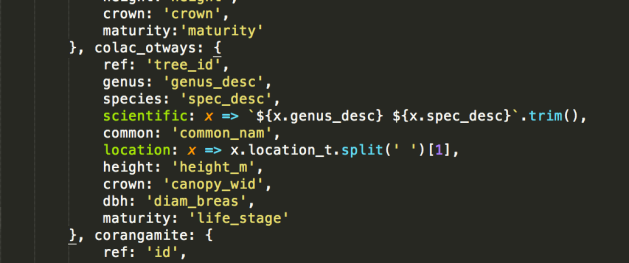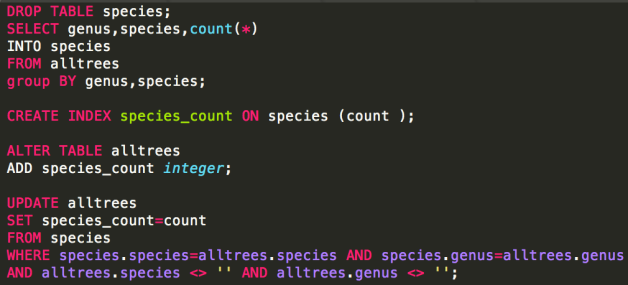I recently re-engineered the data processing behind OpenTrees.org. It’s a website that lets you explore the combined open tree databases of 21 local councils around Australia (over 800,000!), with some pretty data visualisations. Working on this site has taught me a lot about processing data into vector tiles. Today’s lesson: “You might not need PostGIS”.

Trees from Melbourne, Hobson’s Bay and Brimbank.
First version: Tilemill, PostGIS, PGRestAPI
The architecture of v1 looked like this: (See “OpenTrees.org: how to aggregate 373,000 trees from 9 open data sources“).
- Configuration file in JSON stores the location of each source file.
- Bash scripts using JQ (yes, really) to run wget, ogr2ogr and psql to fetch, convert and load each datafile into PostGIS.
- SQL scripts to merge and clean the datasets together into a single schema.
- Tilemill to generate raster tiles from the data.
- PGRestAPI to provide a queryable interface to the data (particularly to allow the map to zoom to a particular tree by ID).
- Nginx serving the front end, built with Mapbox.js (a wrapper around Leaflet).
- The magic of UTFGrid allows interrogating individual tree points. (I still love this technology.)
It worked fairly well, but with the huge disadvantage of having to host a web-accessible server, complete with database.
Second version: Mapbox-GL-JS, vector tiles, static hosting
When I lost access to my free hosting, I re-architected it using Mapbox-GL-JS: v2.
- Same scripts to fetch and process data into PostGIS.
- More scripts which export data out of PostGIS and call Tippecanoe to generate vector tiles, which I then upload to Mapbox.com.
- No Tilemill
- Brand new front-end built using Mapbox-GL-JS, with some clever new data visualisation, such as visualising by “rarity”.
- No PGRestAPI. Clicking on a tree updates the URL to include its lat/long, so you have a shareable link that will go to that tree.
- Front end hosted on Github Pages.
Now we don’t need a server (Github Pages and Mapbox are serving everything we need, and are free). But we still have the heavy dependency of PostGIS.
Do we really need PostGIS?
What is PostGIS actually doing in this scenario? Mostly it’s doing very simple row-oriented, non-relational operations like:

or:

(Yes, I should have used SPLIT_PART())
And then finally we just dump the whole table out to disk.
I began trying to replace it with Spatialite, but that didn’t seem to play very nicely with NodeJS for me. As soon as it got fiddly, the benefits of using it over Postgres began to disappear.
And why did I even need it? Mostly because I already had scripts in SQL and just didn’t want to rewrite them.
So, the disadvantages of PostGIS here:
- It’s a big, heavy dependency which discourages any other contributors.
- The data processing scripts have to be in SQL, which introduces a second language (alongside Javascript).
- No easy way to generate newline-delimited GeoJSON (which would make generating vector tiles a bit faster.)
Third version: NodeJS, Mapbox
So, I rewrote it as v3:
- Replaced the Bash scripts with NodeJS. Which means, instead of the nonsense of JQ, we have sensible looking Javascript for which the JSON config files work well.
- Instead of loading Shapefiles into PostGIS, I convert everything into GeoJSON.
- Instead of SQL “merge” scripts, a NodeJS script processes each tree then writes them all out as a single, line-delimited GeoJSON file.
- Tippecanoe then operates on that file to generate vector tiles, which I upload to Mapbox.
- Split the repository in two: one for the data processing (“opentrees-data“), and a separate one for the front end (“opentrees“). This seems to be a good pattern.
The workflow now looks like:
- 1-gettrees.js uses a configuration file to fetch datasets from predefined locations and save them, in whatever formats, in a standard place.
- 2-loadtrees.js converts each of these files into a geojson file using OGR2OGR.
- 3-processFiles.js loads each of these, processing all the individual trees into a standard schema, then writes out a single combined line-delimited GeoJSON.
- 4-vectorTiles.sh uses Tippecanoe to generate an mbtiles from the GeoJSON.
The processing scripts now look like:


For now, each GeoJSON file is loaded entirely in one synchronous load operation.

(Processing all the GeoJSONs this way takes about 55 seconds on my machine. Loading them asynchronously reduces that to about 45. Most of the time is probably in the regular expressions.)
The only slight hurdle is generating the species count table. With PostGIS, this is just one more query run after all the others:

In NodeJS, our “process each tree once” workflow can’t support this. After processing them once (counting species as we go), we process them all again to attach the species count attribute.

If we were doing a lot of statistics, possibly PostGIS would start to look attractive again.
Do we really need OGR2OGR?
The next dependency I would like to remove is OGR2OGR. It is there because datasets arrive in formats I can’t control (primarily CSV, Shapefile, GeoJSON). I love using Mike Bostock’s shapefile library, but it doesn’t currently support projections other than EPSG:4326. That’s not a showstopper, just more work.
It would also be great not to have to maintain VRT files (in XML!) to describe the CSV formats in which data arrives.








Recent Comments